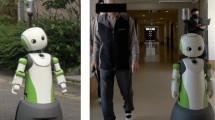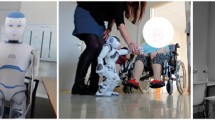Abstract
The effect of wheel height and weight on people’s affordance judgements of a wheeled robot climbing a step was assessed in two experiments. Users must be able to understand their personal service robots’ abilities to perform tasks, such as climbing steps. Robots’ action capabilities can be considered using the theory of affordances. Affordances are the action-relevant relationships between attributes of an actor and attributes of its environment. There is ample evidence that people are sensitive to other people’s affordances. However, only limited research has been conducted to determine whether this generalizes to non-human actors, such as robots. We conducted two experiments which assessed whether people’s affordance judgements of a wheeled robot climing a step are affected by changes in the relationship between step height and robot wheel radius (Experiment 1) as well as weight (Experiment 2). Participants watched brief videos of different robots approaching steps. The participants indicated whether the robot could or could not climb the step. Participants correctly judged that robots which have larger wheel radiuses or are lighter would be able to climb taller steps compared to robots that have smaller wheel radiuses or are heavier. However, participants’ judgments were significantly different from the robots’ actual climbing abilities. This research provided evidence that participants can be sensitive to affordances for non-human actors and might use kinematics when perceiving them. The results indicate that robot users may benefit from viewing a robot’s appearance and movements when judging a robot’s affordances.







Similar content being viewed by others
References
International Federation of Robotics (2016) Service robots. Retrieved from http://www.ifr.org/service-robots/
Elkmann N, Hortig J, Fritzsche M (2009) Cleaning automation. In: Nof SY (ed) Springer handbook of automation. Springer, Berlin, pp 1253–1264
Hockstein NG, Nolan JP, O’Malley BW, Woo YJ (2005) Robotic microlaryngeal surgery: a technical feasibility study using the daVinci surgical robot and an airway mannequin. Laryngoscope 115:780–785
Hicks RW II, Hall EL (2000) Survey of robot lawn mowers. In: Casasent DP (ed) Intelligent robots and computer vision XIX: algorithms, techniques, and active vision. international society for optics and photonics, bellingham, pp 262–269
Watanabe A, Ikeda T, Morales Y, Shinozawa K, Miyashita T, Hagita N (2015) Communicating robotic navigational intentions. In: 2015 IEEE/RSJ international conference on intelligent robots and systems (IROS). IEEE, pp 5763–5769
Green A, Hüttenrauch H, Norman M, Oestreicher L, Eklundh KS (2000) User centered design for intelligent service robots. In: Proceedings on 9th IEEE international workshop on robot and human interactive communication, RO-MAN 2000. IEEE, pp 161–166
Pasteau F, Narayanan VK, Babel MM, Chaumette F (2016) A visual servoing approach for autonomous corridor following and doorway passing in a wheelchair. Robot Auton Syst 75:28–40
Robinson M (2017) Tiny self-driving robots have started delivering food on-demand in Silicon Valley—take a look. Business Insider. Retrieved from http://www.businessinsider.com/doordash-delivery-robots-starship-technologies-2017-3
Gibson JJ (1986) The ecological approach to visual perception. Lawrence Erlbaum Associates Inc., Hillsdale (Original work published 1979)
Chemero A, Turvey MT (2007) Complexity, hypersets, and the ecological perspective on perception-action. Biol Theory 2:23–36
Stoffregen TA (2003) Affordances as properties of the animal-environment system. Ecol Psychol 15:115–134
Turvey MT (1992) Affordances and prospective control: an outline of the ontology. Ecol Psychol 4:173–187
Duchon AP, Kaelbling LP, Warren WH (1998) Ecological robotics. Adapt Behav 6:473–507
Jamone L, Ugur E, Cangelosi A, Fadiga L, Bernardino A, Piater J, Santos-Victor J (2016) Affordances in psychology, neuroscience, and robotics: a survey. IEEE Trans Cogn Dev Syst 10:4–25
Mantel B, Hoppenot P, Colle E (2012) Perceiving for acting with teleoperated robots: ecological principles to human–robot interaction design. IEEE Trans Syst Man Cybern Part A Syst Hum 42:1460–1475
Rome E, Hertzberg J, Dorffner G (2008) Toward affordance-based robot control. Springer, New York
Ugur E, Nagai Y, Sahin E, Oztop E (2015) Staged development of robot skills: behavior formation, affordance learning and imitation with motionese. IEEE Trans Auton Ment Dev 7:119–139
Tipler PA (1999) Physics for scientists and engineers, 4th edn. Macmillan, London
Runeson S, Frykholm G (1983) Kinematic specification of dynamics as an informational basis for person-and-action perception: expectation, gender recognition, and deceptive intention. J Exp Psychol Gen 112:585–615
Runeson S, Frykholm G (1981) Visual perception of lifted weight. J Exp Psychol Hum Percept Perform 7:733–740
Runeson S (1983) On visual perception of dynamic events. Ada Univ Ups Studio Psychol Ups 9:1–56 (Originally published, 1977)
Mark LS (2007) Perceiving the actions of other people. Ecol Psychol 19:107–136
Ramenzoni VC, Riley MA, Davis T, Shockley K, Armstrong R (2008) Tuning in to another person’s action capabilities: perceiving maximal jumping-reach height from walking kinematics. J Exp Psychol Hum Percept Perform 34:919–928
Ramenzoni VC, Davis TJ, Riley MA, Shockley K (2010) Perceiving action boundaries: learning effects in perceiving maximum jumping-reach affordances. Atten Percept Psychophys 72:1110–1119
Stoffregen TA, Gorday KM, Sheng YY, Flynn SB (1999) Perceiving affordances for another person’s actions. J Exp Psychol Hum Percept Perform 25:120–136
Weast JA, Shockley K, Riley MA (2011) The influence of athletic experience and kinematic information on skill-relevant affordance perception. Q J Exp Psychol 64:689–706
Armstrong ME, Jones KS, Schmidlin EA (2014) Tele-operation training the effect of exploration on driveability judgments. Proc Hum Factors Ergon Soc Annu Meet 58:1676–1680
Jones KS, Johnson BR, Schmidlin EA (2011) Teleoperation through apertures passability versus driveability. J Cogn Eng Decis Mak 5:10–28
Jones KS, Schmidlin EA, Wheeler NJ (2012) Can users judge the stair-climbing abilities of two-wheeled self-balancing robots? Proc Hum Factors Ergon Soc Annu Meet 56:1326–1330
Moore KS, Gomer JA, Pagano CC, Moore DD (2009) Perception of robot passability with direct line of sight and teleoperation. Hum Factors J Hum Factors Ergon Soc 51:557–570
Schmidlin EA, Jones KS (2016) Do tele-operators learn to better judge whether a robot can pass through an aperture? Hum Factors J Hum Factors Ergon Soc 58:360–369
Katz JE, Halpern D (2014) Attitudes towards robots suitability for various jobs as affected robot appearance. Behav Inf Technol 33:941–953
Heft H (1993) A methodological note on overestimates of reaching distance: distinguishing between perceptual and analytic judgments. Ecol Psychol 5:255–271
Jacobs DM, Michaels CF, Runeson S (2000) Learning to perceive the relative mass of colliding balls: the effects of ratio scaling and feedback. Percept Psychophys 62:1332–1340
Runeson S, Vedeler D (1993) The indispensability of precollision kinematics in the visual perception of relative mass. Percept Psychophys 53:617–632
Warren WH (1984) Perceiving affordances: visual guidance of stair climbing. J Exp Psychol Hum Percept Perform 10:683–703
Cornsweet TN (1962) The staircase-method in psychophysics. Am J Psychol 75:485–491
Wetherill GB, Chen H, Vasudeva RB (1966) Sequential estimation of quantal response curves: a new method of estimation. Biometrika 53:439–454
Wetherill GB (1963) Sequential estimation of quantal response curves. J R Stat Soc Ser B (Methodol) 25:1–48
Rubin M, Paolini S, Crisp RJ (2010) A processing fluency explanation of bias against migrants. J Exp Soc Psychol 46:21–28
Orne MT (2009) Demand characteristics and the concept of quasi-controls. In: Rosenthal R, Rosnow RL (eds) Artifacts in behavioral research: Robert Rosenthal and Ralph L. Rosnow’s classic books. Oxford University Press, Oxford, pp 110–137
Rosner B (1983) Percentage points for a generalized ESD many-outlier procedure. Technometrics 25:165–172
Bland JM, Altman DG (1997) Statistics notes: Cronbach’s alpha. Br J Med 314:570
Jones KS, Derby PL, Schmidlin EA (2010) An investigation of the prevalence of replication research in human factors. Hum Factors J Hum Factors Ergon Soc 52:586–595
Konczak J, Meeuwsen HJ, Cress ME (1992) Changing affordances in stair climbing: the perception of maximum climbability in young and older adults. J Exp Psychol Hum Percept Perform 18:691–697
Vertesi J (2012) Seeing like a rover: visualization, embodiment, and interaction on the Mars Exploration Rover Mission. Soc Stud Sci 42:393–414
Jacobs DM, Michaels CF (2007) Direct learning. Ecol Psychol 19:321–349
Fajen BR (2008) Perceptual learning and the visual control of braking. Percept Psychophys 70:1117–1129
Fajen BR, Devaney MC (2006) Learning to control collisions: the role of perceptual attunement and action boundaries. J Exp Psychol Hum Percept Perform 32:300–313
Jacobs DM, Michaels CF (2006) Lateral interception I: operative optical variables, attunement, and calibration. J Exp Psychol Hum Percept Perform 32:443–458
Jacobs DM, Runeson S, Michaels CF (2001) Learning to visually perceive the relative mass of colliding balls in globally and locally constrained task ecologies. J Exp Psychol Hum Percept Perform 27:1019–1038
Johansson G (1973) Visual perception of biological motion and a model for its analysis. Percept Psychophys 14:201–211
Author information
Authors and Affiliations
Corresponding author
Ethics declarations
Conflict of interest
The authors declare that they have no conflict of interest.
Additional information
Publisher's Note
Springer Nature remains neutral with regard to jurisdictional claims in published maps and institutional affiliations.
The data presented in this manuscript was previously published as part of the first author’s dissertation.
Rights and permissions
About this article
Cite this article
Wheeler, N.J., Jones, K.S. Kinematics Affect People’s Judgments of a Wheeled Robot’s Ability to Climb a Stair. Int J of Soc Robotics 13, 117–128 (2021). https://doi.org/10.1007/s12369-020-00625-0
Accepted:
Published:
Issue Date:
DOI: https://doi.org/10.1007/s12369-020-00625-0




